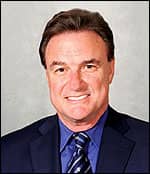by Robert Boyd, DDS
An early adapter talks about how aligners have improved over the years

Orthodontic Products: After more than 10 years of clinical use, how has Invisalign changed since its introduction?
Robert Boyd, DDS: We have watched it evolve from a product that was originally designed just for orthodontists to one that is shared by the whole dental profession. At first it was seen as a “wow” product because of its 3D technology. It was really innovative, and many thought that dentistry would move into more 3D applications—and this is exactly what we have seen now with cone beam imaging and intraoral scanning in restorative dentistry. Invisalign also went to a much wider audience than orthodontists simply using it for minor relapse with the recent emphasis on more complicated cases and on teenagers through the new Teen product.
Because I am also a periodontist, my early involvement in the development of Invisalign was spurred by the advantages I saw for people who had issues related to plaque, gingivitis and periodontitis. There have been studies that have verified that plaque and gingivitis actually decrease when you use Invisalign because people brush more to keep their aligners plaque-free to avoid the foggy and sometimes odorous feeling of plaque in the aligner. Whereas when you get braces, you enter an environment that is harder to keep plaque off.
OP: What have been some of the key new product features added to Invisalign?
Boyd: Quite frankly, the product didn’t work very well in the first 3 to 4 years for many treatments beyond simple malocclusions such as spacing and mild crowding. Although myself and other orthodontists were trying harder cases in these early days, we found that Invisalign could not predictably accomplish a high percentage of these cases by itself, and some of these cases required fixed appliances to finish.

Published studies done at this time reflected this lack of predictability. This led Align Technology into a large bioengineering and product performance research phase. The company established a panel of orthodontists (the Clinical Advisory Board or CAB) to act as consultants. The idea was to try to figure out how high-volume users were doing Invisalign. These meetings established that most doctors had their own unique recipe or style for using Invisalign, oftentimes with almost completely opposite ways of doing the same types of movements.
The original CAB protocol was tested in 2006 and 2007 and developed into a more standardized way of using Invisalign called the “Best Practices Protocol,” which was released in November of 2007. This Best Practices Protocol established new velocities of tooth movement. It also decreased the velocity of certain tooth movements like rotations and extrusions, and adopted more effective attachment designs like the vertical rectangular attachments many of us used and the horizontal beveled attachments designed by Dave Paquette, DDS, MS, MSD.
An even bigger product performance enhancement started in October 2009 when Align introduced other new attachment designs called “optimized attachments.” These new attachments actually push against a flat surface of the attachment in the aligner in the direction that the tooth should be going. This was a different concept than having an aligner move the tooth by creating space for the movement and using the attachment to get a better grip on the tooth.
In 2009 improved tracking of teeth was also introduced, which used new measurements that include the long axis of the tooth to the root apex and the center of rotation of an estimated root size based on the tooth’s crown size.
On the compliance side, new Compliance Indicators on the Teen product provide a way of tracking the total hours of aligner wear by the patient by recording the degree of fade of the color of a blue dot on the aligner.
Quality control has also improved significantly. Aligners fit better now because they’ve improved the tolerances for making the models and making the aligners fit the patient’s teeth better.
But improvements are far from over. Another major new release is coming up in October of 2010. This release includes optimized attachments for premolars, Web site features such as the doctor being able to select elastic hooks to be manufactured directly on the all aligners that need them, and an improved doctor section on the Web site.
OP: The introduction of Invisalign Teen brought the appliance to a crucial patient population. How have aligners performed within this patient group?
Boyd: Many of us who used Invisalign early on found that teenage treatment worked well, as their teeth move more efficiently than an adult’s teeth. A member of the CAB group, Robert Fry, DDS, MS from Kansas City, did a study demonstrating this in 2003–2004. We have recent data from Timothy Wheeler, DMD, Chair of the Department of Orthodontics at the University of Florida, and others that show that age is a factor in rate of tooth movement.
Align Technology also did a poll about using Teen among doctors and parents, and found that parents did not believe their kids would really cooperate fully with the wearing of the aligners, so the company developed the Compliance Indicators. Most of us who have used Invisalign for teenagers feel that kids actually wear the aligners better than adults, as well as having their teeth move more efficiently. Many of us who treated teens realized this was because many teenagers over the age of 14 did not want braces. Orhan Tuncay, DMD, Chair of Temple University’s Orthodontic Department, did a very interesting study and published it in the Journal of Clinical Orthodontics in 2009, which showed that the Compliance Indicators were remarkably consistent within the same patient.
This helped solve what is perceived to be the number one problem with Invisalign, which is that people sometimes do not wear their aligners long enough to be effective.
With Teen, Align also gave three extra sets of aligners, because they also believed from their poll of parents that teen patients would be more likely to lose their aligners. Interestingly, many of us who use the Teen product have come to the conclusion that they do not lose very many aligners and rarely need to use this feature.
OP: What’s the future of using aligners in general? Can they be used to treat more complicated cases?
Boyd: In my opinion, most orthodontists who use Invisalign now as opposed to 8 years ago have more confidence in the product and feel it has become more predictable—if the patient wears the aligners. The focus has changed from Class I malocclusions involving crowding or spacing to mild-to-moderate malocclusions with more significant crowding and spacing, mild inter-arch Class II or Class III corrections, and mild deep or open bite. Many published case reports over the past 5 years have demonstrated effective treatment of these more moderate malocclusions. Recently, even cases of premolar extractions and orthognathic surgery were published. However, we do not have strong evidence from controlled clinical studies to support these results at this time. So the most important question for the doctor is, “Do I want to try aligners for more complex problems or do I want to stay in the zone of not trying new approaches?” I believe that over the last 12 years the “safe zone” has gone from treatment of easy cases to moderately difficult kinds of cases.
I have always thought the question “What does the patient want?” is very important. Over the past 12 years, my practice has been composed of the people who wanted Invisalign and wouldn’t take no for an answer.
For more than 8 years now in my own practice, I have been looking at trying to expand the envelope to figure out how to treat difficult cases. For difficult cases I will tell patients many times that I appreciate their viewpoint but I am not sure exactly how well this difficult treatment will go with aligners, and you must agree that if we do not get the desired result with aligners we will need to put on braces. This gives me the comfort zone I need.
I am part of the small percentage of orthodontists that loves Invisalign, wants to take on challenges, and doesn’t mind telling a patient, “I’m not sure that Invisalign can do this, but I’m willing to try it.” There’s a comfort zone here. Some doctors are willing to do that and other doctors don’t want to get involved in something where it might or might not work.
For more information on the products mentioned here, visit our online Buyer’s Guide.
OP: Increasingly, general dentists are using aligners in their practices. What unique role, then, does the orthodontic specialist play with aligners?
Boyd: This question is interesting because I’m chairman of an orthodontic department and we have many more dental students than orthodontic residents. So, in our school, we decided that you don’t have to graduate from an orthodontic school to be able to learn to treat a mild malocclusion. What we believe is that general dentists should be taught how to do mild malocclusions, and we include that as a standard part of our curriculum.
The scope of the treatment we teach at the Pacific Dugoni School is to treat mild malocclusions, which include crowding and spacing up to 4 mm to 5 mm, but not Class II or III or deep bite. We believe that it is always the doctor’s decision to treat or not to treat. So the doctor has to ask a very simple question: “Am I knowledgeable and skillful enough to treat this patient?” It is really just like other procedures: there are some root canals that are really hard, and there are some root canals that are really easy. There are some crowns that are very simple and straightforward, and there are others that involve multiple crowns and are very involved. I believe all dental schools attempt to show their dental students that there is a range of treatment and you are to treat within the range where your knowledge and expertise lie. For me that is the safe ground, and I feel that dentists do this kind of decision-making on a daily basis over and over again with their patients.
Robert Boyd, DDS, is professor and chairman of the department of orthodontics at the University of the Pacific. He can be reached at








